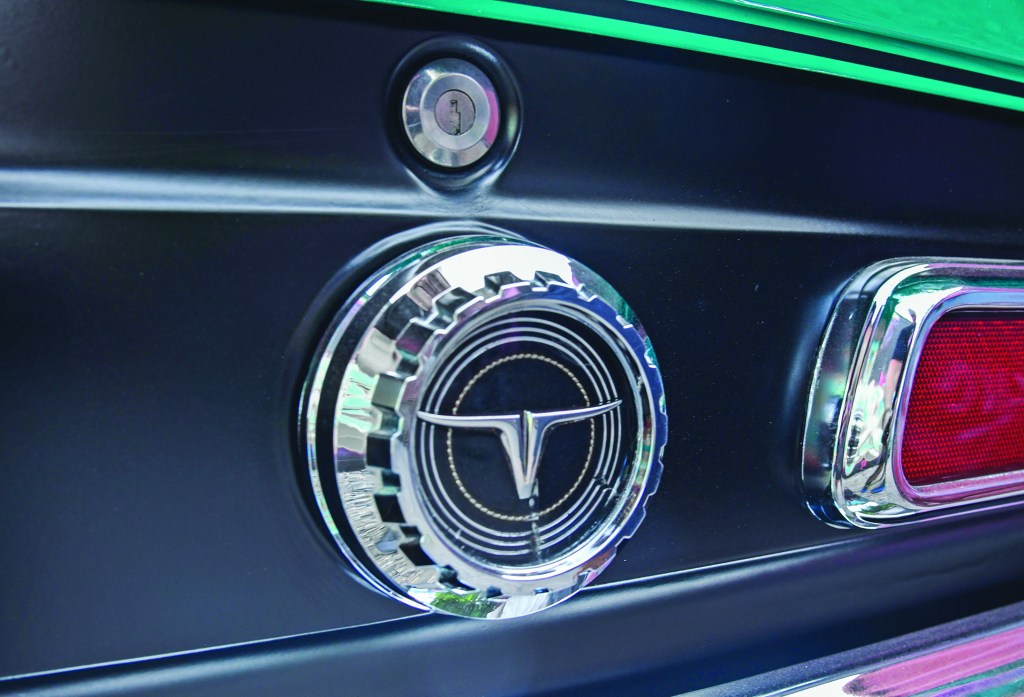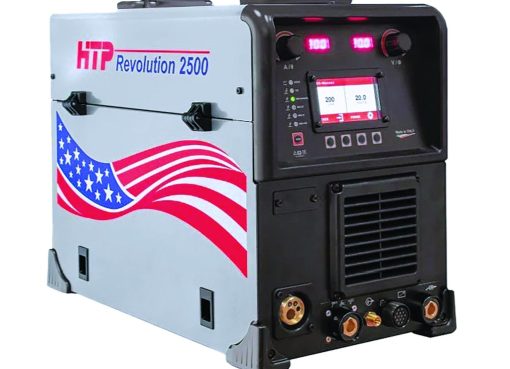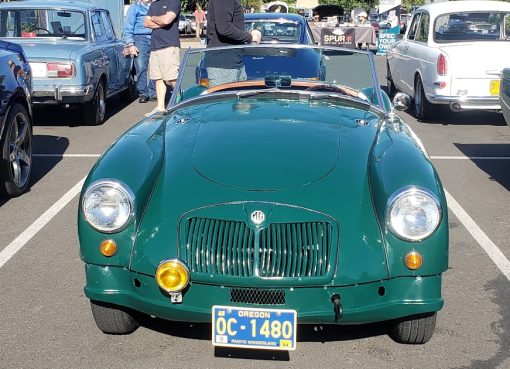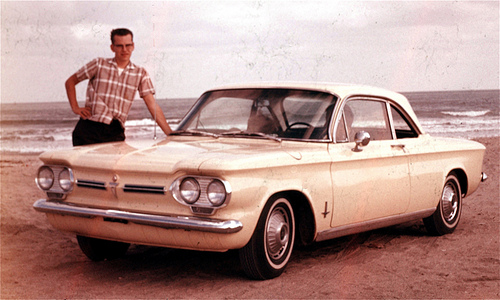This Ford Maverick Grabber Was Built For Street And Strip

Ford’s advertising campaign to push the newly minted Maverick model keyed in on the car’s economy and family workhorse capabilities once the compact hit the dealership floors back in the summer of ’69. It was a timely plan, as Ford needed a replacement for the aging Falcon, but it also needed something to combat the influx of gas-sipping imports that were pouring into the country from all points abroad, many of which were quite inexpensive.
Dearborn’s plan paid off in spades. In the early ’70s, the ability to offer a new car for under $2,000 was a challenging goal for American automakers at a time when the VW Beetle had a base price of $1,799. The Maverick, though small and fairly Spartan in its initial form, seemed like a more substantial car than a Beetle, or any of the Japanese imports that also promised thrifty transport for bargain pricing. So, when the Maverick hit the market with an entry level price of $1,995, consumers responded enthusiastically, enabling Ford’s new import fighter to tally nearly 579,000 in unit sales, not far off the Mustang’s record sales figures from the ’66 model year. The new compact hit the right note with the buying public, and this was reflected in its popularity out on the streets.
However, Ford soon realized it would need to add a little spice to the compact’s model line to keep things interesting. Halfway through the year the company offered the “Grabber” option, which was basically just an appearance package to make the Maverick look more like a trendy muscle ride than just a workaday econo-cruiser. Larger wheels, plus bold exterior colors, a stripe package, racing mirrors, a rear spoiler, and a blacked out grille and rear tail panel gave the dressed-up Maverick the aesthetics of a beefier muscle car, even though the model was still sporting only six-cylinder powerplants under its hood.
In 1971, Ford stepped up its game and made the Grabber its own stand-alone model. It also made a few adjustments to the Maverick’s floorplan so a small-block 302-cu.in. V-8 could now be ordered and slipped right into the engine bay. To make the visual transformation complete, a twin-nostril hood gave the Grabber the true look of a road racer. Though the hood was dropped for the ’73 model year, the Grabber would live on another two years before being excised from the Ford lineup after the ’75 model year.
Nonetheless, the Grabber has lived on as one of those unique rides that has a lot of upsides for the classic-car enthusiast. Though even the Grabber never received anything hotter than a 302 two-barrel with single exhaust, thus keeping it from ever attaining status as a factory performer, its platform—essentially the same as an early Falcon—meant that plenty of performance parts were bolt-on items thanks mostly to the Mustang. That also meant that a Maverick is really just a couple days and a pile of parts away from getting a dose of Ford-engineered performance.

Ford fanatic and all around hot rodder John Holden of Robbinsville, New Jersey, knows of the potential hidden in these fun-size Blue Oval compacts and has sought to exploit their good bones since he was just a teen.
“Though I drove my mother’s ’63 Falcon Sprint convertible when I got my license, the first car I ever bought myself was a 1975 Maverick built with a six-cylinder. I painted it at the body shop where I was employed and began modifying it soon after. First thing I did was to ditch the six and install a stock 302 from a Maverick parts car,” John recalls.
And it didn’t stop there. “I later changed from an automatic trans to a four-speed Toploader. Next, I installed a 9-inch rear, eventually ending with 4.86 gears out back. Then I began drag racing it. After that I built a new 306 engine with lots of speed parts. My best times with that car were in the 12.0s at Atco Dragway on just the motor, but it had a big nitrous kit that I only used for ‘off-highway racing’ in the Toms River area,” John offers with a smirk.
He ended up selling off his compact creation for something with a little more legroom and some hauling capacity out back; “I purchased a ’71 Ranchero GT originally built with a 351 Cleveland engine and a four-speed.” An ’87 Ranger pickup also spent some time in the garage at the Holden household, and even it wasn’t spared from John’s hot rodder tendencies. “I lowered it, did a 302 swap, and did a custom seven-color paint job on it,” he says. Other hot Fords include a ’62 Falcon that John built and still has to this day, along with a 2012 Mustang that he bought new.

After a while, John began to miss his little Maverick. “In 2010 I started the hunt for a suitable Grabber to build into my ultimate street car. I found what I needed by way of my neighbor, Ed. He had a real Grabber that he’d had for years under a tarp,” John says, adding that he’d long tried to buy to no avail. One day Ed and the car were both gone, moved away to parts unknown. John tried to find Ed on the web and even mailed letters to five people with the same name in several different locations, in the hopes of making contact. Finally, nearly a year later, Ed contacted John, and as a bonus, he was now ready to sell his Grabber.
It couldn’t have come at a better time. Ed needed to remove the car from his new address, which turned out to be in Pennsylvania. John could make that happen, and after he went out to look at the car, the two struck a deal and the Grabber came back to Jersey for its metamorphosis into John’s dream version of a Maverick.
He immediately got to work; “Right away I determined that the 302 needed to be rebuilt, so I pulled it and prepped it for the machine shop—I worked with Randy Acolia at AVR Machine in Trenton.” John then sandblasted the engine bay and painted it his favorite Ford color: 1971 Grabber Green. The car was then mechanically stripped of its old paint; however, the roof needed to be blasted due to corrosion from moisture trapped under the car’s vinyl top. A new carbon-fiber Grabber “twin nostril” hood from Maverick Man replaced the original, which had some serious issues from its life in Jersey. “I also scored a pair of fiberglass front fenders from a friend and installed a clean trunk lid that came with the purchase.” Sharp-eyed readers will also notice a set of Mercury Bobcat taillamps were incorporated into the tail panel.

Besides a few minor rust spots that remained, the car was ready for cleanup; the finishing body work was done by John himself. Once the car was finish sanded, he covered the Maverick completely in Grabber Green inside a rented booth at a local body shop. After the paint cured, the stripes were added, and the car was wet sanded and buffed to perfection.
The interior needed some sorting out, so the Maverick received all new upholstery, a fresh carpet and headliner, and three-point seat belts. “I also rebuilt the instrument cluster with a kit by Jack Grice and then added a custom A-pillar gauge pod. Luckily, I scored a perfect dash pad from Ed, the previous owner.” Other highlights included a vintage Pioneer sound system from the ’80s and an original consolette that was scored from another Maverick. John’s best friend Harry Bittner did the wiring.
By now the engine was ready for installation. It had been built with a stroker crank to a healthy 347 cubic inches and then topped with a pair of Trick Flow Specialties 11R 225-cc heads and an Edelbrock Victor Jr. intake mounting a 960-cfm Holley double-pumper from Nickerson Performance. With a 10.5:1 compression, the rebuilt engine now pumps out 508 hp at the crank.

The 347 was then mated to an Astro Performance A-5 version of the T-5 manual. The five-speed transmission feeds that power to the Detroit Locker fitted in the nodular Ford 9-inch rear axle housing. John built up the front suspension with 90/10 shocks and six-cylinder springs. Out back, he added a set of Viking double-adjustable shocks and Cal-Trac bars. The stock disc brakes were used up front, while John added a set of Crown Vic discs in the rear.
A set of Hooker Super Competition headers feed a custom 3-inch exhaust he made at home using mandrel bends and incorporating Magnaflow mufflers for the desired tone. The final touch was adding a set of American Racing Ansen Sprint aluminum wheels, 15 x 6-inch in front and 15 x 8-inch out back. They are shod in 215/65-15 BFG Radial T/As up front and 275/50-15 Mickey Thompson Drag Radials in the rear.
Once the Maverick was completed John took it out to do a few shakedown runs. Right out of the box the car’s combination of elements seemed to work well together. “There weren’t many bugs that I had to fix after first driving it,” he says.

This was important because John needed a vintage ride to get him to his other projects. “I run a cruise night and car show every Thursday at the Friendly’s in nearby Robbinsville [New Jersey]. This is our 11th season, and it just keeps getting better and better. We hold it weekly until the weather turns.” (You can find more information about the cruise and car show here.)
As far as the Maverick’s drivability goes, John couldn’t be happier. “I take it everywhere. With the overdrive and 3.89 gears, it even gets decent gas mileage. It drives straight, rides nice and smooth, and stops great with four-wheel discs. Luckily, the Grabber is a factory air-conditioned car so that makes it even better to drive when it’s hot out.”
Of course, the whole idea behind building this car was for John to be able to enjoy his own version of the ultimate street Maverick, so what does he think after living with it for a while? “It’s been very reliable, but also, a lot of fun. It’s fast! I always get thumbs-up whenever I drive it.” Sounds like mission accomplished.

Specifications – 1972 Ford Maverick Grabber
ENGINE
Block type: Ford “small-block” OHV V-8, 302, Mexican high-nickel casting
Cylinder heads: Trick Flow Specialties 11R, 225-cc intake runners, 2.08/1.60-in valves
Displacement: 347 cubic inches
Bore x stroke: 4.030 x 3.40 inches
Compression Ratio: 10.5:1
Horsepower @ rpm: 508 @ 6,600 RPM
Torque @ rpm: N/A
Camshaft type: Comp Cams hydraulic roller
Camshaft duration: 247/256 degrees, intake/exhaust, @ .050-in lift
Camshaft lift: .587/.579-in, intake/exhaust
Valvetrain: Harland Sharp roller rocker arms
Induction system: Edelbrock Victor Jr. aluminum single-plane intake with Holley 800-cfm “double pumper” built by Nickerson Performance to flow 960 cfm
Ignition system: Ford Duraspark distributor, MSD 6AL-2 control box
TRANSMISSION
Type: Borg Warner T-5 five-speed manual built by Astro Performance to A5 specs
Ratios: 1st/2.95:1 … 2nd/1.95:1 … 3rd/1.36:1 … 4th/1.00:1 … 5th/0.64 … Reverse/2.76:1
DIFFERENTIAL
Type: Ford 9-inch w/ nodular case, Detroit Locker differential, Gleason lightweight gears, and 31-spline Strange axles
Ratio: 3.89:1
STEERING
Type: Ford recirculating-ball, unassisted
Ratio: 20:1
BRAKES
Type: Four-wheel disc
Front: Stock Maverick disc
Rear: Ford Crown Victoria disc
SUSPENSION
Front: Stock Ford Maverick upper and lower control arms with 90/10 shocks and six-cylinder coil springs
Rear: Stock Ford Maverick leaf springs with Viking double-adjustable shocks and Cal-Trac bars
WHEELS AND TIRES
Wheels: American Racing Ansen Sprint aluminum, slot-type
Front: 15 x 6 inches
Rear: 15 x 8 inches
Tires, Front: BFG Radial T/A 215/65-15
Tires, Rear: Mickey Thompson Drag Radial 275/50-15
PERFORMANCE
¼-mile: 11.20 @ 121 mph*
*Best owner-produced time slip from Englishtown Raceway Park and Atco Dragway, both of which are now permanently closed.
The post This Ford Maverick Grabber Was Built For Street And Strip appeared first on The Online Automotive Marketplace.


